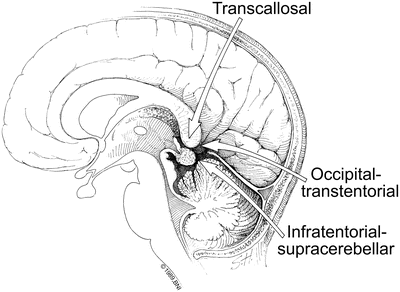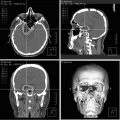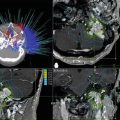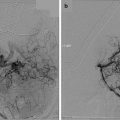Fig. 34.1
Midsagittal section demonstrating the anatomy of the pineal region. Labeled structures include the pineal body (PB), the subforniceal organ (SFO), choroid plexus (CP), area postrema (AP), neurohypophysis (NH), median eminence (ME), and organum vasculorum of the lamina terminalis (OVLT). Used with permission from Barrow Neurological Institute
The pineal region is notable in that it is a region rich in vasculature, especially the deep cerebral veins. The vascular supply to the pineal gland proper is predominantly from the medial posterior choroidal arteries, with contributions from the lateral posterior choroidal and quadrigeminal arteries as well [3]. However, the pineal is surrounded by the deep venous drainage of the brain on all sides—the velum interpositum, containing the internal cerebral veins, lies rostral and dorsal to the pineal gland (to which it is often attached to pineal region tumors by thick arachnoid adhesions) [4], the basal veins of Rosenthal are located at either flank, and the vein of Galen lies posterior and superior to it. For this reason, stereotactic biopsy of the pineal region is viewed with trepidation by some.
The cellular constituents of the pineal region include pinealocytes, astrocytes, and sympathetic nerves. The sympathetic innervation comes from the superior cervical ganglion. The physiological role of the pineal is thought to be concerned with the regulation of circadian rhythms. Ontologically and embryologically the pineal is related to photoreceptor organs. Indeed, this role persists in certain reptiles where the pineal is known as the “parietal eye.” Because of this shared evolutionary background, pineoblastomas are sometimes seen in association with retinoblastoma (so-called “trilateral retinoblastoma”).
Pineal Region Tumor Presentation and Natural History
Although the physiological role of the pineal in humans is still somewhat obscure, it is an important locus of pathology. Broadly speaking, there are four categories of lesions occurring in the pineal region: germinoma (including pure germinoma, teratoma, and nongerminomatous germ cell tumors, NGCTs), pineal parenchymal tumors (pineocytoma and pineoblastoma), glial tumors, and miscellaneous tumors (including metastases, meningioma, and ependymoma).
Although pineal region tumors are relatively rare (accounting for less than 1 % of all intracranial neoplasms), they are much more common in Asia [5]. It is well known that there is a higher incidence of germ cell tumors (GCTs) in Asian populations than in North American or European populations. GCTs typically account for the majority of pineal region tumors, with pineal parenchymal tumors second and miscellaneous tumors third.
In Western populations, GCTs account for 0.3–0.5 % of all primary intracranial neoplasms, but comprise approximately 3.0 % of those encountered in children. In contrast, in Asia, GCTs comprise at least 2.0 %, and up to 9–15 %, of all intracranial neoplasms and pediatric neoplasms, respectively. In Japanese and Korean populations, 80 % of pineal region tumors in patients aged 15–35 years of age are germinoma [6]. In contrast, out of 370 French patients undergoing stereotactic biopsy of pineal region tumors, only 51 % of patients under the age of 30 had radiosensitive tumors (germinoma + pineoblastoma) [7].
The most common presentation of pineal region tumors is from symptoms attributable to local mass effect, principally increased intracranial pressure related to aqueductal compression and/or to mass effect on the quadrigeminal plate (e.g., Parinaud’s syndrome). The growth pattern of pineal region tumors tends to reflect the underlying histology, with benign, well-encapsulated tumors filling the posterior third ventricle, quadrigeminal cistern, and displacing the anterior cerebellum [4]. Malignant tumors are more likely to diffusely infiltrate the midbrain, thalamus, or other neighboring structures.
Importantly, there is tremendous variation in the natural history of pineal region tumors depending on their histology. The management of tumors of this region, therefore, is extremely dependent on an accurate diagnosis. In most cases, this necessitates a tissue diagnosis, whether through stereotactic, endoscopic, or open biopsy. This issue will be discussed in greater detail below.
Pathology
Germ Cell Tumors
Pure germinoma, the most common central nervous system GCT, consists of large undifferentiated cells arranged in monomorphous sheets. Nuclei are round and typically centrally positioned amidst abundant clear cytoplasm. Mitoses are common and necrosis uncommon. Some tumors may incite an inflammatory response that is evident on histology by the presence of either many lymphocytes or occasionally fibrous tissue. Immunohistochemical positivity for placental alkaline phosphatase is typical.
Nongerminomatous Germ Cell Tumors
The group of tumors that together comprise the nongerminomatous germ cell tumors (NGGCTs) include teratoma (mature and immature), yolk sac tumors, embryonal carcinoma, and choriocarcinoma. Only teratoma is commonly encountered as a pure tumor type, with most NGGCTs having regional variations in histology suggestive of multiple tumor subtypes.
By definition, teratomas recapitulate somatic elements from endodermal, mesodermal, and ectodermal lines. Differentiated teratomas include well-formed, fully differentiated elements such as rests of skin, hair, teeth, or cysts of mucosal epithelia. Immature teratomas are much more common, and contain incompletely differentiated tissue. Occasionally, a carcinoma or sarcoma can arise from within a teratoma (so-called teratoma with malignant transformation).
Yolk sac tumors are characterized by a reticular epithelium set in a myxoid matrix; classically these may form papillae known as Schiller–Duvall bodies. Embryonal carcinoma is composed of sheets of large cells with prominent nucleoli, many mitoses, and abundant cytoplasm. Necrosis is common. Trophoblastic elements, such as syncytiotrophoblastic cells (which may be seen scattered with other CNS GCTs) indicate tumor trophoblastic differentiation and hence choriocarcinoma.
The immunohistochemistry of GCTs is helpful in differentiating tumor types. Typically, cell membranes and/or cytoplasm are positive for placental alkaline phosphatase in germinoma; beta-HCG and human placental lactogen in choriocarcinoma, and alpha-fetoprotein in yolk sac tumor and teratoma.
Pineal Parenchymal Tumor
Pineocytomas (aka, pinealocytoma) are slow growing neoplasms of the pineal gland composed of small uniform sized cells. Characteristically, the cells exhibit cytoplasmic processes that are said to resemble club-like endings. Unlike pineoblastomas, there is some preservation of the lobular architecture of the normal pineal gland.
Pineoblastomas are members of the family of small blue cell primitive neuroectodermal tumors, similar to medulloblastoma or retinoblastoma. Like these tumors, they are highly cellular neoplasms with a high nucleus to cytoplasm ratio, characterized by the presence of either Homer–Wright or Flexner–Wintersteiner rosettes, the latter being a mark of retinoblastic differentiation. True to the oncologic commonality between the pineal and photoreceptor organs, pineal parenchymal tumors stain positively for interphotoreceptor retinoid binding protein.
True intermediate tumor classification is relatively rare, with only about 8 % of pineal parenchymal tumors belonging to this category (WHO). These tumors are highly cellular with numerous mitoses and nuclear atypia, but without pineocytomatous rosettes. Even more rarely, a pineal parenchymal tumor may have within it areas of both pineocytomatous and pineoblastomatous differentiation.
Because many tumors of the pineal region are histologically heterogeneous (especially the NGGCTs), the ability of the surgeon to avoid sampling errors in obtaining tissue for histopathological examination is paramount. In general, this need for accurate histological diagnosis of disparate regions of tumor has been commonly cited as support for open or endoscopic biopsies, during which regions of tumor appearing grossly dissimilar can be biopsied separately.
Imaging
Magnetic resonance imaging (MRI) with and without gadolinium contrast enhancement is the diagnostic imaging modality of choice. Pineocytomas are typically hypointense on T1-weighted images, and hyperintense on T2-weighted sequences. Pineoblastomas are heterogeneous, and can be either hypo- to isointense on T1-weighted MRI. GCTs are typically well circumscribed, iso- to hyperdense relative to grey matter, and intensely enhancing. However, no certain method exists for differentiating pineal region tumors on the basis of imaging studies alone.
Tumors of the pineal region enhance variably, as does the normal pineal gland due to the absence of a blood–brain barrier. Incidental calcification of the pineal is common, although such calcifications are also associated with “brain sand” seen in pineocytomas. The diagnosis of GCT is suggested if the neoplasm appears to surround or engulf the normal pineal gland calcifications, whereas pineal parenchymal tumors are said to cause an “explosion” of pineal calcifications to the periphery of the lesion as the mass expands. On the other hand, hemorrhage (pineal apoplexy) is suggestive of choriocarcinoma. In general, tumors arising from the collicular plate are more likely to be of glial origin [1], and the presence of fat signal is characteristic of lipoma, mature teratoma, or dermoid tumors. The presence of mature teratomatous elements such as hair or teeth may also be evident on imaging studies.
Management of Pineal Region Tumors
Because of the varied natural history of pineal region tumors and the lack of diagnostic specificity of imaging studies, the importance of obtaining a tissue diagnosis cannot be overemphasized. Therefore, a biopsy, whether stereotactic, endoscopic, or open (see discussion below) should be obtained as the initial step in the management of tumors of this region in all cases, except where cerebrospinal fluid (CSF) is positive for markers of malignant germinoma (i.e., BHCG or alpha-fetoprotein), in the case of new metastatic lesions (where the tissue diagnosis is already known), or perhaps in patients who are too frail to undergo even a biopsy. As discussed in more detail below, there is no role for empiric radiation therapy in the management of these tumors, at least not in occidental populations.
Whether it is better to perform an open biopsy, coincident with attempted gross total resection or cytoreductive surgery, or to perform a minimally invasive (i.e., stereotactic or endoscopic biopsy) is controversial. Proponents of open biopsy cite the relative safety and low morbidity of approaches to the pineal region given modern instrumentation and microsurgical technique. Because of the histopathologic heterogeneity common to tumors of this region, the ability to minimize sampling errors with open biopsy may yield more accurate specimens for diagnosis. Benign tumors may be completely respectable; therefore, an open approach offers the potential for cure of these lesions. Moreover, even malignant tumors and radiation sensitive tumors may benefit from cytoreduction.
On the other hand, minimally invasive approaches avoid the risks of craniotomy, and have high diagnostic yield. Because of the pineal region’s proximity to the deep cerebral veins, some authors argue that stereotactic biopsy of this region is a relatively higher risk. However, Regis et al. [7] reviewed 370 stereotactic biopsies of the pineal region from 15 Fr neurosurgical centers. They reported a 1.3 % mortality and 0.8 % severe neurological morbidity attributable to stereotactic biopsy. This was believed not to reflect an increased risk of death or neurologic injury over other intracranial sites. Overall, diagnostic tissue was obtained in 94 % of patients. However, 2.3 % of biopsied patients underwent repeat biopsy or subsequent open surgery and were found to have been initially misdiagnosed. Sampling errors were felt to contribute to about half of these cases (i.e., about 1 % diagnostic error due to sampling errors).
The endoscopic approach to the pineal region for the purposes of biopsy was first described by Fukushima [8, 9]. The advantages of an endoscopic approach include direct visualization of the biopsy site which could lessen sampling errors and lead to greater diagnostic accuracy [10]. In addition, because many patients with pineal region tumors either present with, or are at high risk of hydrocephalus, a CSF diversionary procedure may be required. An endoscopic biopsy affords the possibility of simultaneously performing an endoscopic third ventriculostomy at the same operative sitting. Oi et al. reported their experience with 20 consecutive patients followed prospectively who underwent endoscopic biopsy in the initial management of their pineal region tumors [11]. Importantly, they reported the endoscopic detection of spread of tumor not visualized in preoperative neuroimaging. This suggests that endoscopy may have benefit as a diagnostic tool per se. Nevertheless, the proper role of the endoscope in the management of pineal region lesions remains controversial.
The Role of Surgery
Pineal region tumors can be successfully resected with microsurgical techniques at tolerable levels of morbidity and mortality. Approaches to the pineal region include both supratentorial (interhemispheric transcallosal and occipital transtentorial) and infratentorial (supracerebellar infratentorial approach, Fig. 34.2). Bruce and Stein [12] described their experience with 160 pineal region tumors. They achieved a gross total resection in 46/53 benign pineal region tumors, with overall mortality and morbidity of 4 % and 3 %, respectively. Their results are comparable to other major surgical series for whom mortality rates range from 2 to 11 % and serious morbidity from 3 to nearly 30 % (for a recent review, see [13]).


Fig. 34.2
Surgical approaches to the pineal region. Midsagittal section of the human brain demonstrating the surgical corridors to the pineal region, the transcallosal, occipital transtentorial, and the supracerebellar infratentorial. Used with permission from Barrow Neurological Institute
The role of surgery for maximal debulking and/or resection is best established for benign lesions, where gross total resection may be curative. Conversely, these are also the lesions best suited to radiosurgical treatment. The argument for surgery for benign pineal region tumors is that gross total resection is often possible, and that this may afford a permanent cure and obviate the need for CSF diversion.
Whether surgical resection or debulking plays a significant role in the management of malignant tumors is much more hotly debated. Aggressive malignancies, especially those that on preoperative imaging are seen to invade the brainstem or other neighboring structures, are unlikely to be amenable to complete resection. Nevertheless, some studies have shown benefit of cytoreduction even in these cases, although these data have not reached statistical significance [14, 15]
Finally, some centers advocate “second-look” surgery if imaging abnormalities persist after initial treatment of NGGCTs with chemotherapy and radiation [13]. The majority of these surgeries find either necrosis or, in the case of mixed NGGCTs, rests of mature teratoma.
Role of Radiation
It has been known for decades that radiation is curative for intracranial germinoma [16], with 5-year survival rates of up to 95 % reported for pure germinoma and up to 76 % for NGGCTs. Indeed, radiation remains the mainstay of treatment of most pineal region tumors, whether as primary treatment modality or as adjuvant therapy. Nevertheless, radiation has significant morbidity. Efforts at reducing radiation exposure have included avoiding whole brain and prophylactic craniospinal irradiation, the use of chemotherapy, and radiosurgery.
Traditionally, germinoma was treated with craniospinal irradiation, given estimates of spinal cord metastasis or seeding after surgery range of 13–40 %. However, as the sequelae of prophylactic craniospinal irradiation have become more appreciated, efforts have been made to delay or avoid spinal irradiation, and to limit cranial irradiation from whole brain to local field. The effectiveness of partial brain fields comprising tumor plus a 2-cm margin was shown initially by Dattoli and Newall in 1990 [17]. In this retrospective study, 12 patients were treated with partial brain irradiation, consisting of either fields comprising tumor plus a 2-cm margin (n = 10), or fields comprising the ventricular system with a boost to the tumor (n = 2). Nine out of ten patients treated with partial brain irradiation were complete responders; however, one patient relapsed and ultimately succumbed to the disease. This patient, however, also received a reduced dose of less than 40 Gy. Thus, the authors concluded that whole neuraxis radiation could be safely avoided in the majority of patients, provided that sufficient tumoricidal doses of radiation were delivered.
Because gonadal GCTs respond well to chemotherapy, chemotherapy has been advocated as a means to further reduce the amount of radiation necessary to obtain control of the tumor. In this regard, the rationale for chemotherapy anticipates the argument made for radiosurgery. Balmaceda et al. [18] enrolled 71 patients with GCTs (including both pure and NGGCTs) in an international cooperative study comprising 31 institutions in 6 countries, and demonstrated that chemotherapy could not be used alone for the treatment of GCTs. They employed a high-dose regimen of carboplatin, etoposide, and bleomycin. Although 41 of the 71 patients were successfully managed with chemotherapy alone initially, 35 patients showed evidence of recurrence or progression. Furthermore, 7 of 71 patients treated died of chemotherapy related toxicity.
In contrast, Buckner et al. [19] reported the results of a Phase II trial of primary chemotherapy followed by reduced-dose radiation for the treatment of CNS GCT in which the partial brain dose was reduced to 30 from 54 Gy. All patients were alive without progression at 51-month mean follow-up. One patient relapsed distally (spinal cord) and was salvaged with spinal irradiation. Thus, the prevailing paradigm at the present time is to use chemotherapy as an adjuvant therapy in combination with reduced-dose radiation. Spinal irradiation should be reserved for those cases presenting with disseminated disease or in the case of relapse.
The Role of Radiosurgery
The role of radiosurgery in the management of pineal region tumors remains controversial. Traditionally, pineal region tumors have either been approached surgically with the goal of gross total resection and cure (if benign), or with conventional radiation if the tumor is of a histology known to be radiosensitive and/or malignant. Radiosurgery, on the other hand, has the potential to be used either as a “boost” modality in conjunction with conventional radiotherapy, or even as an alternative to radiotherapy and/or surgery altogether.
Table 34.1 summarizes the results of reports in the English language literature, including three from our institution, on the use of stereotactic radiosurgery in the treatment of pineal region tumors. Several factors, however, make it difficult to draw easy comparisons or conclusions from these studies, including relatively small sample sizes and because of the heterogeneity of diagnoses included within individual series.
Table 34.1
Summary of pineal region tumors in literature
Reference | No. and diagnosis | Biopsy | Mean follow-up (months) | Prior treatment | Radiological results | Dosimetry | Progression | Complication |
|---|---|---|---|---|---|---|---|---|
Backlund et al. (1974) [20] | 2 pineocytoma | 2 SB | 13 and 36 | None | Regression of tumor | GKRS 50 Gy | None | None |
Dempsey and Lunsford (1992) [32]
Stay updated, free articles. Join our Telegram channel
Full access? Get Clinical Tree
 Get Clinical Tree app for offline access
Get Clinical Tree app for offline access

|





